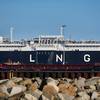The Hanseatic Port of Hamburg on Germany's Elbe River has never shied from innovative means of moving citizens and visiting ship's crew from the south shore harbor area to the beautiful city spread along the river's north shore. In 1911 they built, and continue to use, a tunnel that requires that cars be lowered one at a time in elevators to the sub river level, then drive through the tunnel to be elevated to road level on the other side. The elevator buildings reflect the design sensibilities of the picturesque Northern European port at the same time as displaying the ports continuing trade driven affluence.
On the water, sightseeing tourists and commuting workers are moved by a flotilla of ferries representing everything from fine lined vessels with passenger seating in the hulls and a pleasing low profile flowing down a gentle sheer line to a fine fantail stern. These old favorites could never be adapted to today's fast paced bustle and the modern need for serious people movers. That is left to an innovative new series of boats operated by HADAG Seetouristik und Fährdienst AG.
These 98 x 26-ft. (30 x 8-m) boats have capacity for 250 passengers with stowage space for up to 50 bicycles, handicapped accessible hydraulically operated loading ramps as well as enclosed and open seating. What makes all of this so remarkable is that the vessels are operated safely by only one person.
The success of the vessels cannot be credited to any one feature. It is in the total vessel, starting with the identified needs and concept from the experienced people at HADAG and the resulting design from Netherlands naval architect Fred Van DenBerg. The operator works from a large enclosed bridge mounted on an arch right aft on the vessel and well above the open second deck. Passengers board aft on the ramps that are controlled from and can be seen through windows in the floor of the wheelhouse.
The wheelhouse also has 100 percent visibility of the open upper deck and closed circuit television observation of the enclosed main deck.
The engine room can also be monitored by closed circuit TV. The superstructure is all aluminum to reduce weight, displacement and wake. Sound has been kept to 65 decibels or less in passenger areas.
The beamy steel hull has a shallow 5-ft. (1.5 m) draft and it is here that the most essential component of the ferry's success is found. A pair of open wheeled Rolls Royce/Aquamaster US381 CRP azimuthing drives are mounted in a finely faired hull. The hulls rounded chine and enhanced design reduces wake while assuring powerful water flows throughout the Z-drives' 360-degree rotation. Power to the drives comes from a pair of six-cylinder, 14-liter Cummins N14 engines. These electronically controlled engines give the fast response and power required by the operator in maneuvering around the busy harbor traffic. An 75 kW Aquamaster bow thruster further enhances dockside maneuverability while negating the need for mooring lines and line handlers.
The Cummins, like all other components on the boat, were chosen only after careful comparison and negotiation. They won the prestigious place due to their ability to cope with the heavy load conditions and strong service support from the local Cummins dealer Otto Blank in Hamburg. The first of the 98-ft. (30-m) boats was delivered in 1997 and now has 17,000 trouble free hours on the Cummins engines. The last of this class boat was delivered in January 2002 and, as of late March, had 2000 hours on the mains.
Electrical needs are met by a pair of Cummins 6BT-powered 75 kW generators.
The ferry system in Hamburg handled only two million people in 1996. This has now increased to four million in 2001 with 2.5 million of those carried on a single route that has four boats leaving at 15 minute intervals on its one-hour round trips — that operate from 5:15 a.m. to 11:45 p.m.
The success of the 98-ft. (30-m) boats led to plans for a 82 x 20-ft. (25 x 6-m) vessel with 114-passenger capacity to serve some of the smaller canals in and around the city. These boats will have a 9-ft. (3-m) air draft, compared to the larger boats' 28 ft. (8.5 m), in order of pass under more of the bridges of a city that claims more of them than Venice. Each of the new boats, designed by German naval architect Dr. Christian Masilge of Berlin, will have only one of the Cummins N14 main engines and RR/Aquamaster drives with a 35 kW bow thruster. Like the last of the 30-metre boats, the drives on the smaller boat have a pair of five and four-bladed contra-rotating open NiAlBr 950 m/m diameter propellers. Two of these vessels will be delivered in May of this year.
Subscribe for
Maritime Reporter E-News
Maritime Reporter E-News is the maritime industry's largest circulation and most authoritative ENews Service, delivered to your Email five times per week










